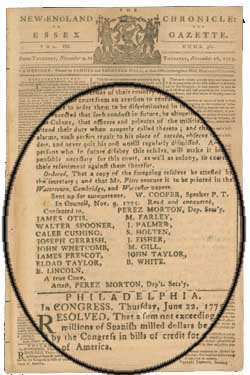Collections Online
"Philadelphia. In Congress, Thursday, June 22, 1775."
To order an image, navigate to the full
display and click "request this image"
on the blue toolbar.
-
Choose an alternate description of this item written for these projects:
- Main description
[ This description is from the project: Coming of the American Revolution ]
This November 1775 newspaper article from the New-England Chronicle: or, The Essex Gazette announces the printing of $3 million in paper notes to help pay mounting military expenses. It also outlines how much each colony must invest in the bills in the form of tax revenue.
Issued in defense of American liberty
As Congress quickly discovers, creating and maintaining a continental army is an expensive undertaking. In the summer of 1775, in order to pay its mounting military expenses, Congress authorizes the release of $3 million in bills of credit, or paper notes. Issued in various denominations, the bills function as short-term public loans to the government. Each colony is expected to "sink," or invest in, a certain proportion of the bills by collecting taxes from its inhabitants. The first bills arrive from the printer and enter circulation in August 1776. To foil counterfeiters, the notes are printed on paper containing blue fibers and mica chips. By the end of 1775, Congress will authorize another $3 million in bills of credit.
To examine the entire issue of this newspaper, please see the online display of the New-England Chronicle: or, The Essex Gazette, 9-16 November 1775.
Questions to Consider
1. According to this newspaper article, what are the different denominations of bills to be printed?
2. What is the "reward" for signing continental bills?
3. How does Congress determine what portion of the bills each colony is responsible for paying? Which colony bears the greatest burden? Which colony bears the smallest?
4. When are the colonies expected to make payments on the notes?
5. What is the salary allotted to the continental treasurers? What is their function?

